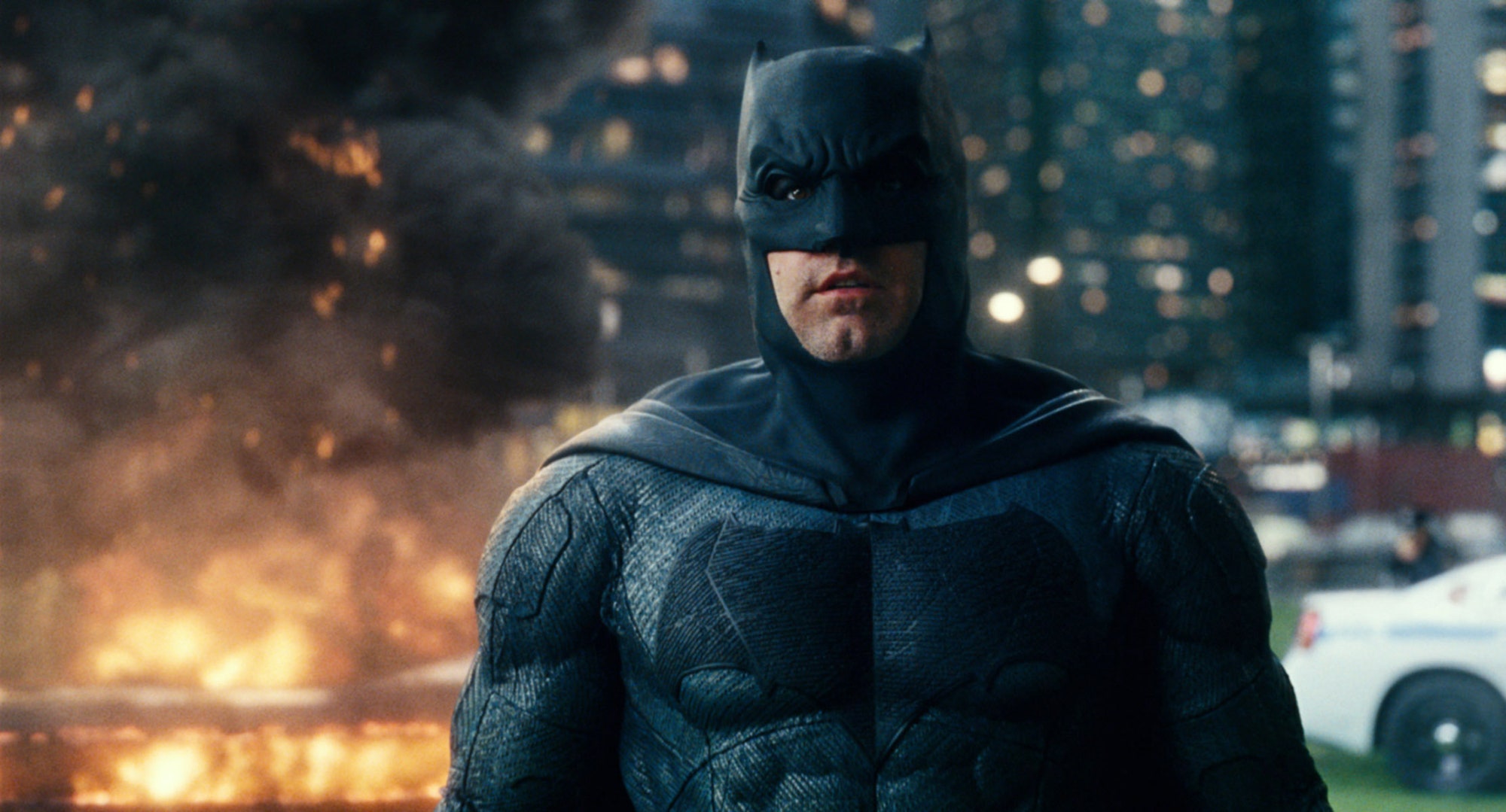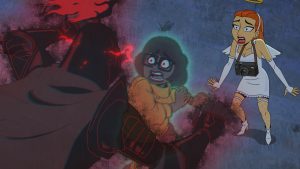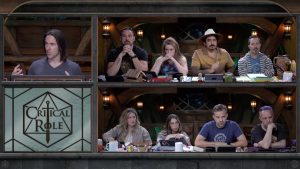
Superstitious and cowardly, a criminal just watch Batman take down two of her armed and powerful comrades. Desperation drives her to take the one option left to her, the sole chance she has to escape the Batman’s wrath. Pointing a gun at the 10-month-old baby she and her colleagues kidnapped, the criminal shouts, “Back off, man! I’ll kill the kid.” When Batman does not respond, she yells louder, fearing that the Dark Knight doesn’t take her seriously. “Believe me man, I will! Believe me–”
Bearing the weapon he took from another criminal, Batman shoots the criminal, killing her instantly. He grabs the toddler before he can hit the ground and nestles the boy safely against his chest. “I believe you,” Batman intones.
It should come as no surprise that the above scene from The Dark Knight Returns means a lot to director Zack Snyder. After all, he recreates it nearly beat for beat in Batman v Superman: Dawn of Justice, swapping out a 10-month-old for the auspiciously named Martha (Diane Lane). Snyder brings up the scene several times in a recent interview with Joe Rogan, while also telling the host that he feels keeping Batman from killing makes the character “irrelevant.” For Snyder, the moment from The Dark Knight Returns justifies his decision to have Batman kill in his movies, a storytelling choice in the early days of the now-dead DCEU that earned the ire of many fans.
While he’s not wrong to ground his reading in one of the most important and influential comic book stories of all time, Snyder is wrong about the Caped Crusader. No, Zack Snyder, Batman does not need to kill.
Distorting Deconstruction
“I do take a deconstructivist point of view,” Snyder tells Rogan explaining his approach to well-regarded characters with a strong fan base. “People are always like ‘Batman can’t kill,’ so Batman can’t kill is canon. And I’m like, ‘Well, the first thing I want to do when you tell me that…’” Snyder doesn’t finish the sentence, instead giving way for he and Rogan to chuckle together at the thought.
Harmless as the chuckling is, the fact that Snyder can’t finish the sentence right away speaks volumes about his (mis)understanding of deconstructionism, let alone how Alan Moore and Frank Miller applied the approach to superheroes. Deconstructionism is a subset of postmodern philosophy, one that embodies theorist Jean-François Lyotard’s definition that postmodernism is a refusal to believe in grand narratives. Rather than accept grand narratives as transcendental givens, the deconstructionist breaks down concepts to uncover the beliefs and assumptions driving them.
That approach can be seen in the two comics that Snyder cites as his biggest influences, Watchmen and The Dark Knight Returns. In the former, writer Alan Moore and penciler Dave Gibbons imagine superheroes not as arbiters of virtue, but as victims of power politics. Without the opportunity to express that power, they feel totally impotent. But when the power is granted them, they gain strength and even the power to help other people, something necessary in light of nuclear holocaust.
In The Dark Knight Returns, Miller presents Batman as less a hero and more a “terrorist who fights the right enemies.” His Batman relishes the pain and suffering he can inflict, and he traces the cause of modern evil to pop psychology, inept police forces, and the media. Batman saves the day by exposing all of these forces as the source of trouble in the modern world, creating followers such as Carrie Kelley, the new Robin.
According to Snyder, these two comics prevent him from accepting the standard readings of Batman, Superman, and other heroes that he’s worked on. “If you’ve read those two comics, it’s hard to go back,” he explains. And, to be sure, his work does flirt with deconstructionism — at least when he’s copying Miller, Moore, and other like-minded creators. He expresses no doubt in the grand narrative that these creators and their works are influential and important comics.
Snyder recalls an early pitch meeting in which he showed a producer a copy of Frank Miller’s 300, promising that his approach would be to shoot the images on the page. And even though his adaptation of Watchmen does have some significant departures from the book, much of it recreates Gibbons’ artwork panel by panel.
Furthermore, when he talks about superheroes, he uses terminology familiar to anyone insecure about their interest in the genre. “Superhero movies are modern myth,” he enthuses. “We have Superman and Batman. Are they not the mythic answer to a lot of modern questions about how we should live?” Snyder looks to Superman as a response to “all the fucking shit we run up against, whether it be war, class struggle … relationships with different countries.” Through Superman, he argues, we see a point of view “that is not helpless in the face of the insanity that is the 20th century.”
Snyder clearly has no problem accepting on faith certain grand narratives. So why does he insist that Batman must kill?
The Unrealistic Beauty of Batman
“I didn’t realize it was canon that Batman can’t kill,” Rogan mulls in response to Snyder’s observations. “That seems ridiculous given the circumstances in which he operates.”
Loathe as I am to type these words, I must admit: Joe Rogan makes a good point here. It is ridiculous that Batman sees a clear moral distinction between killing someone and leaving them paralyzed for life. Then again, it’s ridiculous that he allows the Joker to live again and again, letting the villain go on to take more lives. Heck, it’s ridiculous that a billionaire would put on a bat suit and fight crime.
But if you’re coming to Batman for realism, you’re making a huge mistake. Instead, everything about Batman is contrived, which allows creators and readers to explore complex ideas from a hyperbolic perspective. When, say, Batman and Ra’s al Ghul take off their shirts to sword fight in the desert, Denny O’Neil’s heightened dialogue and Neal Adams’ fluid figure work transcend a mere action sequence and turn their clash into one of philosophical import.
In other words, the plot and character choices in a Batman story have little to do with realism and everything to do with the creators’ beliefs and assumptions. A true deconstructionist would take pleasure in breaking down what the parts of a Batman story reveal about those beliefs and assumptions.
As literary critic and leading thinker of deconstructionism J. Hillis Miller puts it in his book The Ethics of Reading, “If there is to be such a thing as an ethical moment in the act of reading, teaching, or writing about literature, it must be sui generis [unique/of its own kind], something individual and particular.” In other words, reading, as Snyder does in fact do when he translates Batman stories to the screen, reveals truths only about the reader and their individual desires and beliefs.
So when Snyder puts Batman in a situation where he must kill, he’s saying more about how he understands the world than he is anything about how to imagine heroes. He ignores the many times that Batman chooses not to kill in The Dark Knight Returns, such as saving Harvey Dent, or when the Joker undermines Batman by killing himself and framing the Caped Crusader. Instead, he focuses on the time when Batman does kill because that reveals his primary interest in superheroes as power fantasies.
At no point in his filmography does Snyder practice deconstruction. Instead, he treats the power fantasy as an unavoidable given that cannot be questioned.
Batman and the Moral Power of Imagination
Snyder’s lack of understanding of deconstruction should come as no surprise to anyone familiar with his oeuvre. Watching Snyder movies is like watching a body builder stand in the rain and read the index to a philosophy 101 textbook. The smart words make the speaker seem cooler, but they have no depth or meaning. They’re just signifiers.
In light of his surface-level approach, Snyder’s justification seems odd. “You’re protecting your god in a weird way. You’re making your God irrelevant,” Snyder says about those who insist that Batman must not kill. But Snyder’s statement misunderstands fans’ feelings about the character.
When fans insist that Batman doesn’t kill, they’re not protecting their god. Rather, they’re acknowledging the unrealistic, imaginary nature of genre storytelling, and asking creators to treat them as such.
Grant Morrison, the writer behind some of the best Superman and Batman comics ever made, puts it best when they describe the way comic books can inspire people to do good works in their actual lives: “I don’t need a realistic Superman who gets beaten up because no such thing will ever exist,” they told Paste. “[T]he real Superman who does exist is made of paper, and can be a pure absolute ideal because he’s not real. He actually saves kids’ lives.”
Whenever anyone tells a story about Batman, they’re presenting an unreal world of their own creation. That world abides by no other rules than those the storyteller considers worthy of attention. Miller knew that when he imagined Batman killing a criminal to save a baby, because he needed an extreme world to justify his extreme Dark Knight. Snyder echoes the scene because he thinks it looks cool and he thinks that Miller is cool.
If Snyder were intellectually honest, then he could admit that simple reasoning. Instead, his insistence on realism and pushing Batman to extremes only proves that he’s a poor writer of superheroes and a worse deconstructionist.
The post No, Zack Snyder, Batman Doesn’t Need to Kill appeared first on Den of Geek.







